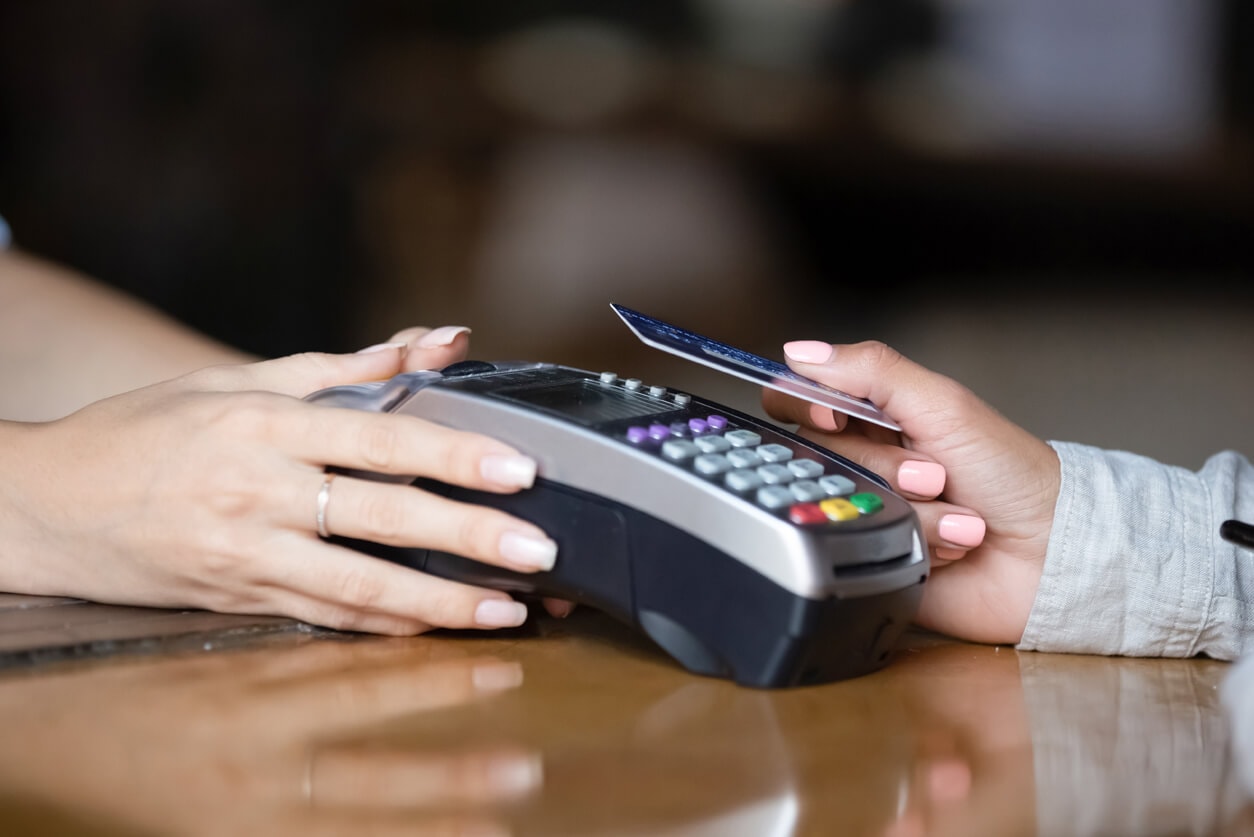How Do You Swipe a Credit Card Properly?
6 Min Read | Published: June 19, 2024

This article contains general information and is not intended to provide information that is specific to American Express products and services. Similar products and services offered by different companies will have different features and you should always read about product details before acquiring any financial product.
Learn how to swipe a credit card for smooth transactions and to help prevent errors. See other ways that you may be able to use your credit card as well.
At-A-Glance
- Alignment, direction, and speed matter when you swipe your credit card.
- Swiping your credit card incorrectly may prevent the transaction from processing properly.
- While magnetic stripes are being phased out and replaced with microchips, many credit cards today have both the magnetic stripe and a microchip.
A magnetic stripe credit card is a type of card that allows you to conduct transactions by swiping the card.
Magnetic stipes are slowly being phased out in favor of microchip technology, which is more secure. However, many credit cards today have both a stripe and a chip, allowing the cardholder to either swipe or “dip” their card by inserting it into the point-of-sale (POS) machine. This allows you to pay at merchants that haven’t yet upgraded their card reader to a new chip-enabled one.1
In this article, we’ll show you how to swipe a credit card in just a few easy steps.
How to Swipe a Card Properly

Swiping a credit card is easy to do. Just follow these three steps:

Make Sure Your Credit Card Is Properly Aligned
Position your card so that the magnetic stripe is down and facing the card reader. Insert the corner of your card into the card reader’s swipe terminal.

Swipe From Top to Bottom
Swipe your card from the top to the bottom of the terminal. Credit card readers require a top-to-bottom swipe motion to read the information on the magnetic stripe properly.

Speed Matters
The speed should be swift and steady for best results. If your first swipe doesn’t work, the machine may prompt you to try again.
After you’ve swiped your card, you may be prompted to enter your zip code if you’re paying by credit card or your PIN (personal identification number) if you’re using a debit card.
How Not to Swipe a Card
Position, direction, and speed are the three components of a proper credit card swipe. If your swipe doesn’t register, then there’s a chance that you may be doing one of those things wrong. To help your credit card payment be processed, try swiping again using a different speed. Make sure you’re going top to bottom and the magnetic stripe touches the card reader.
Sometimes, a transaction failure is due to a malfunction of the magnetic stripe on the credit card. Cards can sometimes become demagnetized if they are stored next to items with electromagnetic fields, such as cell phones or digital cameras. Touching them with refrigerator magnets or magnets on the back of tape measures and flashlights can have the same effect.2
The physical condition of your credit card could also be a factor in a transaction being denied. Always store your credit card in a soft place, like a wallet or purse, where the magnetic stripe won’t get scratched. Any permanent damage to that stripe could make the card unusable, no matter how many times you swipe it.
Other Ways to Use Your Card
In addition to magnetic stripe card readers, there are a few different ways you may be able to pay with your credit card today:
- Inserting the Card’s Chip (EMV)
Swiping isn’t the only way to use a card. Most credit cards issued in the United States today also have EMV chips (which stands for Europay, Visa, Mastercard) that store the cardholder’s account information. These microchips offer a more secure alternative to magnetic strips. That’s because EMV cards use an encrypted digital signature that changes with each transaction. This is in contrast to magnetic stripes, where the information does not change.3
With an EMV card, you insert the card into the card reader with the chip facing up. Leave it until the payment is processed and the machine prompts you to remove it. You may be prompted to enter your PIN or asked for your signature.
- Tap for a Contactless Payment
Contactless cards are also on the rise and are currently one of the safest forms of payment.4 Many card readers today have technology that allows you to pay just by tapping your card, or your mobile phone that has a digital wallet. With this form of payment, you simply tap the phone or card onto the card machine. Look for the three curved lines that look like a Wi-Fi symbol. You’ll want to tap your card (or phone) against that.
Frequently Asked Questions
Magnetic stripe credit cards have a stripe on the back made of iron particles in plastic film. That stripe is magnetized and encoded with the cardholder’s account data. You transfer that information when you swipe the card through a point-of-sale system.5
EMV chips are more secure than magnetic stripes. That’s because they use an encrypted digital signature that changes with each transaction. EMV cards may also require the user to enter a PIN number or sign for the transaction.
Contactless cards are considered one of the most secure forms of payment. They eliminate many of the ways that hackers can steal your information. Tap cards produce a transaction-specific, one-time code that cannot be duplicated or reproduced.6
The Takeaway
The magnetic stripe on your credit card is encoded with your account information. When you swipe the card, the reader decodes the data. The transaction may not go through if the card is swiped improperly, or if the magnetic stripe is demagnetized or damaged in some way.
1, 3, 5 “Magnetic Stripe Card: Definition, How It Works, vs. Chip Card,” Investopedia
2 “How Do Cards Become Demagnetized?,” BluCurrent
4 “What Is A Contactless Credit Card?,” Forbes Advisor
6 “Are Contactless Credit Cards the Safest Way to Pay?,” CNET Money
SHARE
Related Articles
Is Contactless Payment a Wiser Choice?
Discover the surge in contactless payments, offering convenience and security through tap-to-pay technology and mobile wallets for faster and safer transactions.
What Is a Credit Card and How Do They Work?
Before you apply for a credit card, you'll want to know which options are available and how they work. Learn more about the different types of credit cards.
What Is a Credit Card Number?
Credit card numbers may seem random, but each digit serves a specific purpose, like identifying the credit card issuer, the card network, and more.
The material made available for you on this website, Credit Intel, is for informational purposes only and intended for U.S. residents and is not intended to provide legal, tax or financial advice. If you have questions, please consult your own professional legal, tax and financial advisors.











